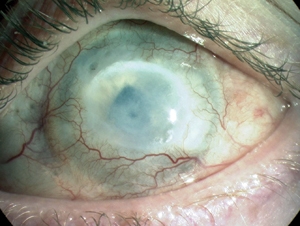Chemical eye injury
Editor-In-Chief: Prab R Tumpati, MD
Obesity, Sleep & Internal medicine
Founder, WikiMD Wellnesspedia &
W8MD medical weight loss NYC and sleep center NYC
| Chemical eye injury | |
|---|---|

| |
| Synonyms | N/A |
| Pronounce | N/A |
| Specialty | N/A |
| Symptoms | Eye pain, redness, tearing, blurred vision, swelling |
| Complications | Corneal ulcer, glaucoma, cataract, vision loss |
| Onset | Immediate |
| Duration | Varies, can be long-term |
| Types | N/A |
| Causes | Acid or alkali exposure |
| Risks | Occupational hazard, household cleaning products |
| Diagnosis | Eye examination, pH testing |
| Differential diagnosis | Conjunctivitis, foreign body in the eye |
| Prevention | Protective eyewear, safety protocols |
| Treatment | Irrigation, topical antibiotics, steroids, surgery |
| Medication | N/A |
| Prognosis | Depends on severity and promptness of treatment |
| Frequency | Common in industrial settings |
| Deaths | N/A |
Overview of chemical eye injuries
Introduction[edit | edit source]
A chemical eye injury occurs when a chemical substance comes into contact with the eye, potentially causing damage to the cornea, conjunctiva, and other ocular structures. These injuries can result from exposure to acids, alkalis, or other chemical agents and can lead to varying degrees of vision impairment or blindness.
Causes[edit | edit source]
Chemical eye injuries are typically caused by accidental splashes of chemicals, improper handling of substances, or exposure to chemical vapors. Common sources include household cleaning agents, industrial chemicals, and laboratory reagents. Alkali burns, such as those from ammonia or sodium hydroxide, tend to penetrate ocular tissues more deeply than acid burns, making them particularly dangerous.
Symptoms[edit | edit source]
Symptoms of a chemical eye injury can vary depending on the type and concentration of the chemical involved. Common symptoms include:
- Severe pain and burning sensation
- Redness and irritation
- Tearing and inability to open the eye
- Blurred vision
- Swelling of the eyelids
Diagnosis[edit | edit source]
Diagnosis of a chemical eye injury involves a thorough examination by an ophthalmologist. The assessment may include:
- Visual acuity test
- Slit-lamp examination
- pH testing of the ocular surface
- Fluorescein staining to assess corneal damage
Treatment[edit | edit source]
Immediate and copious irrigation of the eye with water or saline is crucial to minimize damage. The goal is to restore the normal pH of the ocular surface as quickly as possible. Further treatment may include:
- Topical antibiotics to prevent infection
- Cycloplegic agents to relieve pain
- Corticosteroids to reduce inflammation
- Surgical intervention in severe cases
Prognosis[edit | edit source]
The prognosis of a chemical eye injury depends on the severity of the burn and the promptness of treatment. Mild injuries may heal with minimal intervention, while severe injuries can lead to permanent vision loss or require corneal transplantation.
Prevention[edit | edit source]
Preventive measures include wearing appropriate personal protective equipment (PPE) such as goggles or face shields when handling chemicals, ensuring proper storage and labeling of chemical substances, and having emergency eyewash stations readily available in workplaces.
See also[edit | edit source]
Search WikiMD
Ad.Tired of being Overweight? Try W8MD's physician weight loss program.
Semaglutide (Ozempic / Wegovy and Tirzepatide (Mounjaro / Zepbound) available.
Advertise on WikiMD
|
WikiMD's Wellness Encyclopedia |
| Let Food Be Thy Medicine Medicine Thy Food - Hippocrates |
Translate this page: - East Asian
中文,
日本,
한국어,
South Asian
हिन्दी,
தமிழ்,
తెలుగు,
Urdu,
ಕನ್ನಡ,
Southeast Asian
Indonesian,
Vietnamese,
Thai,
မြန်မာဘာသာ,
বাংলা
European
español,
Deutsch,
français,
Greek,
português do Brasil,
polski,
română,
русский,
Nederlands,
norsk,
svenska,
suomi,
Italian
Middle Eastern & African
عربى,
Turkish,
Persian,
Hebrew,
Afrikaans,
isiZulu,
Kiswahili,
Other
Bulgarian,
Hungarian,
Czech,
Swedish,
മലയാളം,
मराठी,
ਪੰਜਾਬੀ,
ગુજરાતી,
Portuguese,
Ukrainian
Medical Disclaimer: WikiMD is not a substitute for professional medical advice. The information on WikiMD is provided as an information resource only, may be incorrect, outdated or misleading, and is not to be used or relied on for any diagnostic or treatment purposes. Please consult your health care provider before making any healthcare decisions or for guidance about a specific medical condition. WikiMD expressly disclaims responsibility, and shall have no liability, for any damages, loss, injury, or liability whatsoever suffered as a result of your reliance on the information contained in this site. By visiting this site you agree to the foregoing terms and conditions, which may from time to time be changed or supplemented by WikiMD. If you do not agree to the foregoing terms and conditions, you should not enter or use this site. See full disclaimer.
Credits:Most images are courtesy of Wikimedia commons, and templates, categories Wikipedia, licensed under CC BY SA or similar.
Contributors: Prab R. Tumpati, MD


